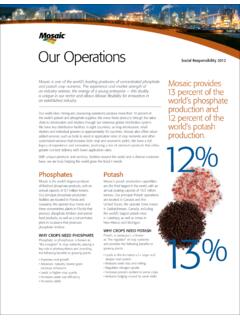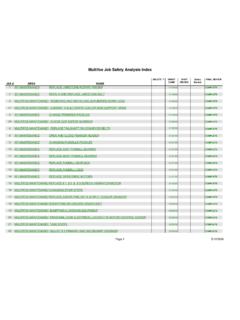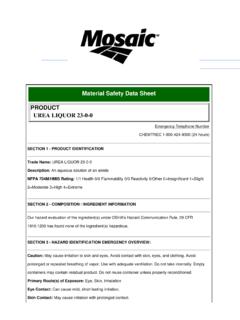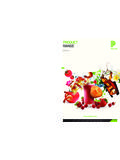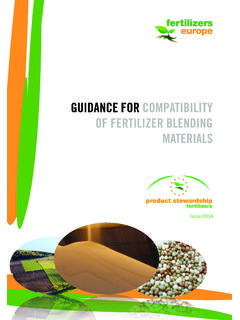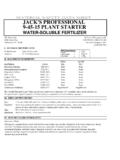Transcription of SAFETY DATA SHEET SECTION 1 PRODUCT AND …
1 Status: Revised Page 1 of 7 Issue Date: 06/01/2015 SECTION (s) Revised: Sect 15 SDS #: MOS 100038 Revision Date: 4/30/2018 SAFETY data SHEET SECTION 1 PRODUCT AND company IDENTIFICATION Trade Name: MicroEssentials SZ Chemical Name: Monoammonium Phosphate with Ammonium Sulfate and Sulfur and Zinc CAS Number: 7722-76-1 Chemical Family: Ammonium Phosphates Inorganic Salts Synonyms: Monoammonium Phosphate + Sulfur and Zinc Monobasic Ammonium Phosphate + Sulfur and Zinc Ammonium Dihydrogen Phosphate + Sulfur and Zinc MAP + S + Z Ammonium Dihydrogen Orthophosphate Primary Use: Crop nutrient company Information: THE MOSAIC company 3033 Campus Drive Plymouth, MN 55441 800-918-8270 or 763-577-2700 8 AM to 5 PM Central Time US Emergency Telephone: EMERGENCY OVERVIEW 24 Hour Emergency Telephone Number: For Chemical Emergencies: Spill, Leak, Fire or Accident Call CHEMTREC North America: (800) 424-9300 (reference CCN201871) Others: (703) 527-3887 (collect) SECTION 2 HAZARD IDENTIFICATION GHS Classification.
2 Acute Toxicity Oral Category 5 Skin Irritant Category 2 Eye Irritant Category 2B STOT SE Category 3 Hazard Statement H303 Hazard Statement H315 Hazard Statement H320 Hazard Statement H335 Signal Word: WARNING Hazard Statement(s) H303: May be harmful if swallowed H315: Causes skin irritation H320: Causes eye irritation H335: May cause respiratory irritation Label Elements: Prevention: P264: Wash thoroughly after handling. P280: Wear protective gloves P261: Avoid breathing dust P271: Use only outdoors or in a well-ventilated area. Response: P302+ P352 IF ON SKIN: Wash with plenty of water.
3 P321 Specific Treatment, see supplemental first aid information. P332+ P313 If skin irritation occurs: Get medical advice/attention. P362+ P364 Take off contaminated clothing and wash it before reused. P305+P351+ P338 IF IN EYES: Rinse cautiously with water for several minutes. Remove contact lenses, if present and easy to do. Continue rinsing. Status: Revised Page 2 of 7 Issue Date: 06/01/2015 SECTION (s) Revised: Sect 15 SDS #: MOS 100038 Revision Date: 4/30/2018 P337+ P313 If eye irritation persists: Get medical advice/attention. P304+ P340 IF INHALED: Remove person to fresh air and keep comfortable for breathing.
4 P312 Call a POISON CENTER. Storage: Not applicable Not applicable Disposal: P501 Disposal of content/containers to be in accordance with local/regional/national regulations. SECTION 3 COMPOSITION INFORMATION ON INGREDIENTS Formula: Proprietary Composition: Monobasic Ammonium Phosphate Ammonium Sulfate Sulfur Zinc Compounds (Proprietary) CAS 7722-76-1 CAS 7783-20-2 CAS 7704-34-9 Proprietary 75-78% 12-15% 4-6% Acute Toxicity Oral Category 5 Skin Irritant Category 2 Eye Irritant Category 2B STOT SE 3 (Lungs, Inhalation) SECTION 4 FIRST AID MEASURES First Aid Procedures: Eyes: Move victim away from exposure and into fresh air.
5 Flush eyes with plenty of clean water for at least 15 minutes. If symptoms persist, seek medical attention. Skin: Wash contaminated area thoroughly with mild soap and water. If chemical or solution soaks through clothing, remove clothing and wash contaminated skin. If irritation develops and persists after washing, seek medical attention. Inhaled: If respiratory symptoms develop, move victim away from source of exposure and into fresh air. If symptoms persist, seek medical attention. Ingestion: If large amounts are swallowed, seek emergency medical attention. If possible, do not leave victim unattended and observe closely for adequacy of breathing.
6 Note to Physician: If person has been exposed to concentrated decomposition products, treat symptomatically and watch for delayed symptoms of pulmonary edema. SECTION 5 FIRE FIGHTING MEASURES Extinguishing Media: Use extinguishing agent suitable for type of surrounding fire. Avoid excessive water to minimize runoff. Prevent firefighter water from entering the environment. Small fires: Water spray, foam, dry chemical or CO2 Large fires: Water spray, fog or foam Protection of Firefighters: Positive pressure, self-contained breathing apparatus is required for all firefighting activities involving hazardous materials.
7 SECTION 6 ACCIDENTAL RELEASE MEASURES Response Techniques: Stay upwind and away from spill (dust hazard). Wear appropriate protective equipment, including respiratory protection, as conditions warrant (see SECTION 8). Prevent spilled material from entering sewers, storm drains, other unauthorized treatment drainage systems, and natural waterways. Notify appropriate federal, state, and local agencies as may be required (see SECTION 15). Minimize dust generation. Sweep up and package appropriately for disposal. Status: Revised Page 3 of 7 Issue Date: 06/01/2015 SECTION (s) Revised: Sect 15 SDS #: MOS 100038 Revision Date: 4/30/2018 SECTION 7 HANDLING AND STORAGE Handling: The use of appropriate respiratory protection is advised when concentrations exceed any established exposure limits (see SECTION 8).
8 Avoid contact with eyes, skin, and clothing. Wash thoroughly after handling. Wash contaminated clothing or shoes. Use good personal hygiene practices. Avoid systems that would tend to segregate dust or any components of this PRODUCT . Avoid accumulation of fugitive dust, as high concentrations of sulfur dust may present an explosion hazard. Follow standard safe-work practices, including hot-work procedures when working around this PRODUCT . Storage: Use and store this material in dry, well-ventilated areas. Store only in approved containers. Keep container(s) tightly closed. Keep away from any incompatible material (see SECTION 10).
9 Protect container(s) against physical damage. Material may absorb moisture from the air. SECTION 8 EXPOSURE CONTROLS / PERSONAL PROTECTION Engineering Controls: Use process enclosure, general dilution ventilation or local exhaust systems where necessary to maintain airborne dust concentration below the OSHA standards or in accordance with applicable regulations. Personal Protective Equipment (PPE): Eye/Face: Approved eye protection to safeguard against potential eye contact, irritation, or injury is recommended. Skin: The use of cloth or leather work gloves is advised to prevent skin contact, possible irritation and absorption.
10 Respiratory: A NIOSH approved air purifying respirator with a type 95 (R or P) particulate filter may be used under conditions where airborne concentrations are expected to exceed exposure limits. Protection provided by air purifying respirators is limited (see manufacturer's respirator selection guide). Use a positive pressure air supplied respirator if there is potential for uncontrolled release, exposure levels are not known or any other circumstances where air purifying respirators may not provide adequate protection. A respiratory protection program that meets OSHA's 29 CFR and ANSI requirements must be followed if workplace conditions warrant a respirator.

